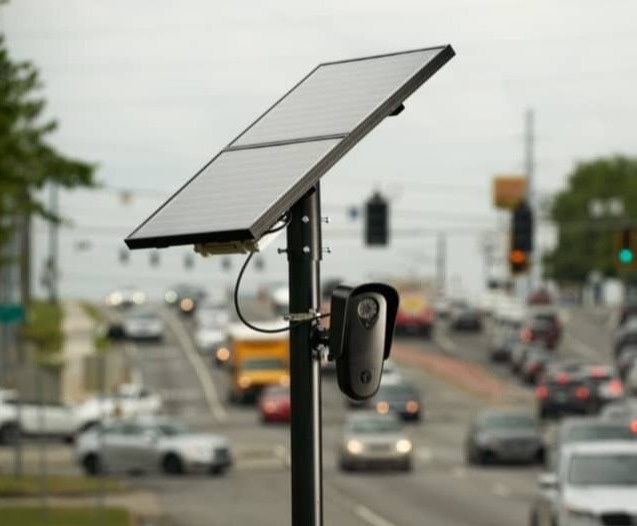Automated license plate readers (ALPRs) are computer-controlled camera systems that can read license plates. It’s a simple concept, but the technology is not without controversy. Authorities have been early adopters of the surveillance tool; it can help police locate suspects, or catch speeders who are creating unsafe environments for others. But, condos and HOAs have started to use ALPR to keep their communities safer. While this solution won’t work for every residential community, it may be a viable option for yours.
A brief overview of ALPRs
ALPRs collect license plate numbers and location data. They also document the exact date and time each vehicle passes by the reader. Some systems are even able to capture the make and model of vehicles. ALPRs are very quick and can collect license plate data in less than a second.
Static cameras
Levels of sophistication vary depending on the type of system a customer selects. There are “standard” plate readers that are typically mounted on street poles, overpasses, or some other stable structure. The cameras automatically capture license plate numbers that come into view, along with the date and time. The data is automatically uploaded and saved, usually to a cloud.
Condos and HOAs that use this type of surveillance tool may have the cameras positioned outside of the community, or at the entrance of a parking garage. The motion-activated cameras take pictures of each car plate. All footage is owned by the association. In most cases, photos are only reviewed if there is an incident or if local authorities request to see the data. No one should be watching the ALPRs on a regular basis; that’s not what they were designed for.
Cameras that collaborate with access control software
More technologically advanced condos are trying a new way to regulate resident and visitor parking. These parking systems are touchless, fobless, and use automated license plate recognition cameras with cloud-based software to grant access to pre-approved residents and visitors.
The cameras work in tandem with a software that maintains a database of all valid plates. Once it’s up and running, the camera does a scan of the plate and the software decides if the barrier can be lifted or not depending on whether the plate is in the database.
Now let’s weigh the pros and cons of this security solution.
Pros
They can help increase security
When it comes to cameras that work with access control software, building security may instantly be improved. Since only those with authorization can get into the parking area, it becomes harder for strangers to gain access. Buildings may also blacklist specific vehicles if they know the drivers of those cars have created problems for the community in the past.
Static ALPRs give associations records that can also come in handy if there was ever a vandalism incident or other criminal issue that occurred on the property. Furthermore, when people know they are being watched , they are less likely to exhibit inappropriate behavior.
They can increase revenue, or at least reduce operating costs
With automated access control, there is no need to have a guard or attendant onsite. Associations may also make more revenue if they charge for visitor parking. Instead of trying to catch guests who sneak into the lot, residents will have to obtain a pass legitimately. Once this is done, admins can enter the guest’s plate into the database.
Experts believe these cameras do not increase liability for the association
Attorneys who specialize in association law generally believe that installing ALPRs does not increase liability for security. In fact, it’s much more common for HOA lawsuits to include claims of negligent security. Tools that can offer proof or evidence are not a bad thing.
Roads and parking garages are also public, or at least semi-public places. As such, drivers cannot expect complete privacy. Capturing license plates is very legal because anyone could document the license plates of vehicles that pass by.
They can help solve crimes
When a serious crime occurs at a condo or HOA, ALPRs may be able to provide evidence to police. As an example, one HOA became the scene of an unfortunate drug-related death. The association was able to use a license plate reader to narrow down vehicles coming in and out. The police were given access to the photos, and it helped them find the individual who sold the drugs to the person who passed away.
They can provide additional convenience to residents
Instead of having to rummage through pockets or purses to find their fobs, residents can seamlessly get in and out of their parking garages.
Cons
It’s more work for the association
It takes resources to install and maintain camera systems. The association must consider costs, make a maintenance plan, and determine who can review footage. They must also think about how long data will be stored, and where it will be archived.
They can cause privacy concerns
Just because ALPRs don’t generally increase liability for associations doesn’t mean residents will like the idea of having them around. Residents may protest the installation of license plate readers because they feel like it will infringe on their privacy.
ALPRs sometimes misread plates
Even technology can make a mistake. It is possible that the camera may misread a plate or mistake it for another if the plate is old and weathered.
They can be an additional source of stress for residents
If the camera misreads a plate and the control access system won’t open the gate for an authorized resident, they’re not going to be happy about it. These systems could create occasional problems for the people that use them regularly. It’s also an added inconvenience for residents that have to speak to an admin if they need to register guests with the association.
Best practices
There are a couple of important points to keep in mind if you are considering an ALPR system for your community.
Be transparent Create a policy Ensure the costs are worth the results
You should be as transparent as possible with residents when introducing this safety tool. Depending on your governing documents, owners may need to vote on this issue before you can move forward. Even if owner support is not required, the association should tell residents about the new system before it’s installed, and post a sign by the cameras once the technology is in place. The sign should be visible and state that video surveillance or photos of license plates are taken upon entry of the community or parking area.
Policies help associations standardize processes and procedures. Condos and HOAs are strongly encouraged to create a policy for plate readers. The policy should include information such as:
The purpose of the cameras What happens when footage is created What happens if footage is needed for evidence Who can view footage How to make a request to view footage How long footage is archived How footage is destroyed
With a policy, it will be easier for staff to determine when it is appropriate to let a resident review an image or video, as well as how to handle and dispose of footage.
Finally, associations should run the numbers and make sure that the costs required to operate an ALPR system will be outweighed by the benefits. Though they are generally one of the more affordable security options, it may not make sense to have such a system in your community.
Written by Condo Control Central Blog | Shared from Condo Control Central Blog











